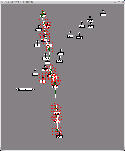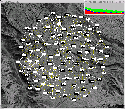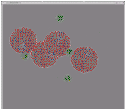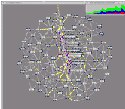Fantastic Data has developed an integrated sensor protocol suite for the US Army CERDEC. It is flexible, low-power, capable of scaling to a very large network (1000 nodes), and can be easily implemented in small and inexpensive hardware. The communications protocol includes the novel sas medium access protocol that is capable of rapidly switching from asynchronous, contention service to synchronous, clear-channel service depending upon node state, data load, and data criticality. The use of a hybrid approach has allowed us to optimize performance and power consumption.
Variable forward error correction coding and an innovative, link-level multicast acknowledgement and retransmission protocol provide enhanced reliability in this difficult radio environment. We have integrated the sas medium access protocol with the distributed data cache and the collaborative tracker to produce an integrated sensor node software suite. This suite has been tested in a simulated environment on a 100 node network and in a realistic field test with 25 nodes.
 Fantastic Data developed a sensor node to showcase the cooperative sensor and
distributed communications protocols. The fully integrated sensor node
includes a PIR sensor, a GPS receiver for precision time and location
measurements, a 2.4 GHz low power modem, a 3-axis magnetometer, a
processor, and memory. The deployed node provides real-time
surveillance for about 6 days powered by 2 AA batteries. The
weatherproof enclosure allows outdoor operation. The node measures 192
cm³ and weighs about 140g. Batteries make up about a third
of the volume and more than half the weight. Another third of the
volume is empty to provide the correct focal length between lens and
sensor. Fantastic Data’s sas protocol allows the sensors to
communicate, form a mesh, and share target detections in order to
detect and track targets in a secure area. Fantastic Data’s power
control protocols and localized data dissemination extend the lifetime of the
autonomous devices.
Fantastic Data developed a sensor node to showcase the cooperative sensor and
distributed communications protocols. The fully integrated sensor node
includes a PIR sensor, a GPS receiver for precision time and location
measurements, a 2.4 GHz low power modem, a 3-axis magnetometer, a
processor, and memory. The deployed node provides real-time
surveillance for about 6 days powered by 2 AA batteries. The
weatherproof enclosure allows outdoor operation. The node measures 192
cm³ and weighs about 140g. Batteries make up about a third
of the volume and more than half the weight. Another third of the
volume is empty to provide the correct focal length between lens and
sensor. Fantastic Data’s sas protocol allows the sensors to
communicate, form a mesh, and share target detections in order to
detect and track targets in a secure area. Fantastic Data’s power
control protocols and localized data dissemination extend the lifetime of the
autonomous devices.
The first prototype nodes have been built and tested. The second generation design is under development. It is about one fourth the size with a projected lifetime of over 90 days.
Field Experiment
A field experiment was conducted in May 2006 at Ft. Monmouth, New Jersey. 25 sensor
nodes were hastily deployed along two intersecting paths. Intruders were tracked
and the performance of the nodes was measured and recorded. The Field Experiment animation
shows the tracking of an actual intruder through the deployed sensor network.
Emulation
The operation of the sensor node is tested and visualized in an emulation
environment. The 4 emulation animations illustrate the operation of the
cooperative sensor network in various states.
References
Hammel, T., Rich, M., Graff, C.
Design of a Sensor Protocol Suite for VLSI Implementation. In Military Communications
Conference, 2005 (MILCOM 2005) (Atlantic City, NJ, October 20, 2005). IEEE Press,
2005, Vol. 4, 2421-2426. paper presentation
Hammel, T., Rich, M. A higher capability sensor node platform suitable for demanding applications. In Information Processing in Sensor Networks Conference, 2007 (IPSN 2007) (Cambridge, Massachusetts, April 25, 2007). ACM Press, 2007. paper presentation
Sensor Node User's Guide. May 25, 2006. manual
 Field Experiment |
 Network Formation |
 Busy Network |
 Quiet Network |
 Tracking |